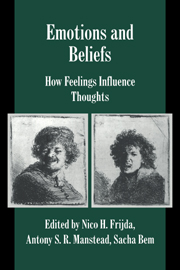Book contents
- Frontmatter
- Contents
- Contributors
- 1 The influence of emotions on beliefs
- 2 Feeling is believing: Some affective influences on belief
- 3 Beliefs through emotions
- 4 The sentiments and beliefs of distributed cognition
- 5 Feeling is believing? The role of processing strategies in mediating affective influences on beliefs
- 6 The formation of beliefs at the interface of affective and cognitive processes
- 7 Anxiety, cognitive biases, and beliefs
- 8 A cognitive dissonance theory perspective on the role of emotion in the maintenance and change of beliefs and attitudes
- 9 Relationship beliefs and emotion: Reciprocal effects
- Index of authors
- Index of subjects
- Studies in Emotion and Social Interaction
8 - A cognitive dissonance theory perspective on the role of emotion in the maintenance and change of beliefs and attitudes
Published online by Cambridge University Press: 10 March 2010
- Frontmatter
- Contents
- Contributors
- 1 The influence of emotions on beliefs
- 2 Feeling is believing: Some affective influences on belief
- 3 Beliefs through emotions
- 4 The sentiments and beliefs of distributed cognition
- 5 Feeling is believing? The role of processing strategies in mediating affective influences on beliefs
- 6 The formation of beliefs at the interface of affective and cognitive processes
- 7 Anxiety, cognitive biases, and beliefs
- 8 A cognitive dissonance theory perspective on the role of emotion in the maintenance and change of beliefs and attitudes
- 9 Relationship beliefs and emotion: Reciprocal effects
- Index of authors
- Index of subjects
- Studies in Emotion and Social Interaction
Summary
… following the earthquake, the vast majority of the rumors that were widely circulated predicted even worse disasters to come in the very near future. Certainly the belief that horrible disasters were about to occur is not a very pleasant belief, and we may ask why rumors that were “anxiety provoking” arose and were so widely accepted. Finally a possible answer to this question occurred to us -an answer that held promise of having rather general application: perhaps these rumors predicting even worse disasters to come were not “anxiety provoking” at all but were rather “anxiety justifying.” That is, as a result of the earthquake these people were already frightened, and the rumors served the function of giving them something to be frightened about. Perhaps these rumors provided people with information that fitted with the way they already felt.
(Festinger, 1957: vi–vii)The above quotation, which appeared in the Foreword to A Theory of Cognitive Dissonance, describes how Leon Festinger and his colleagues arrived at the theory of cognitive dissonance, one of the most influential theories in psychology (Jones, 1985). According to the theory (Festinger, 1957), the presence of a cognitive inconsistency of sufficient magnitude will evoke a negative emotional state that will motivate cognitive work aimed at reducing the cognitive inconsistency. For the theory, a cognition is an element of knowledge. Cognitions can be beliefs, attitudes, values, and feelings about oneself, others, or the environment. Thus, the theory of cognitive dissonance is concerned with the cognitive antecedents of emotion, the intensity of emotional response, and the cognitive regulation of this emotional response.
- Type
- Chapter
- Information
- Emotions and BeliefsHow Feelings Influence Thoughts, pp. 185 - 211Publisher: Cambridge University PressPrint publication year: 2000
- 45
- Cited by

